Synthesis of Current Knowledge of the Morphology of the Larval Stages of Paederinae (Coleoptera; Staphylinidae), with a First Insight into the Mature Larva of Pseudomedon Mulsant & Rey, 1878, in the Light of a New Systematic Division
Simple Summary
Abstract
1. Introduction
The State of Research on the Developmental Stages/Larval Stages of Paederinae
2. Materials and Methods
2.1. Material Examined
2.2. Study Techniques
3. Results
3.1. Subfamily Diagnosis of the Mature Larvae (L2) of Paederinae
3.2. Generic Diagnosis of the Mature Larva (L2) of Pseudomedon
3.3. Description
Morphological Description of Mature Larva (L2) of Pseudomedon obsoletus
4. Discussion
4.1. Larval Characters at the Tribal Level in Paederini and Lathrobiini Sensu Novo
4.2. Comparison of the Larval Characters of Lathrobiini Sensu novo at the Inter- and Intrasubtribal Level
4.3. Key to Genera of the Known Larvae of Paederinae
- 1
- Sensory appendage of the antenna on the outer side of segment III …………… ..……………………………………………………….………….……….……Ochtephilum
- -
- Sensory appendage of the antenna on the inner side of segment III …….….………….2
- 2
- Head rounded, buccal cavity wide, ligula conical …….………………….………………3…………………………………………….………………………….Paederus, Paederidus
- -
- Head of a different shape, buccal cavity narrow, ligula bulbiform or pear-shaped …………………………………………………………………..………….……….……..4…………………………….…Lathrobium, Tetartopeus, Medon, Pseudomedon, Rugilus
- 3
- Prosternum, tergite and sternite of abdominal segment VIII uniform, tuft of cuticular processes on epipharynx short, 2/3 of outer margin of mandible toothed ………………………..……………………………………………………………………….……….….. Paederidus
- -
- Prosternum, tergite and sternite of abdominal segment VIII divided, tuft of cuticular processes on epipharynx long, 1/3 of inner margin of mandible toothed .……………….….………………………………………………………………………………………..Paederus
- 4
- Central part of anterior margin of nasale concave, mala shorter than article I of maxillary palp ……………………..……………………………………………………….…………..5……………………………………………….……………..Pseudomedon, Medon, Rugilus
- -
- Central part of anterior margin of nasale distinctly conical, mala not shorter than article I of maxillary palp ……………………………………………………………….……….6……………………………………………………………..……..Lathrobium, Tetartopeus
- 5
- Apotome present, ligula wide at base (wider than base of article I of labial palp), no channel on epipharynx …..……..…………………………………………………………..…….7…………………………………………………………………………Pseudomedon, Medon
- -
- Apotome absent, ligula narrow at base (narrower than base of article I of labial palp), many channels on epiphaynx …………….…………..………..…….………………….Rugilus
- 6
- Neck wide, median tooth of nasale narrow, mandible with inner margin serrate ……………………………………………………..……………………….…….Tetartopaeus
- -
- Neck narrow, median tooth of nasale wide, mandible with inner margin smooth …………………………………………………………………………………Lathrobium
- 7
- Single row of cuticular processes along anterior margin of buccal cavity in central part…………..……………………………………..…………………..……..…..…Pseudomedon
- -
- A few rows of cuticular processes along anterior margin of buccal cavity in central part………………………………………………………………………..….…………..…Medon
5. Conclusions
Author Contributions
Funding
Institutional Review Board Statement
Informed Consent Statement
Data Availability Statement
Acknowledgments
Conflicts of Interest
References
- Żyła, D.; Bogri, A.; Heath, T.A.; Solodovnikov, A. Total-evidence analysis resolves the phylogenetic position of an enigmatic group of Paederinae rove beetles (Coleoptera: Staphylinidae). Mol. Phylogenet. Evol. 2021, 157, 107059. [Google Scholar] [CrossRef] [PubMed]
- Schomann, A.; Solodovnikov, A. Phylogenetic placement of the austral rove beetle genus Hyperomma triggers changes in classification of Paederinae (Coleoptera: Staphylinidae). Zool. Scr. 2017, 46, 336–347. [Google Scholar] [CrossRef]
- Frania, H.E. Larvae of Eustilicus Sharp, Rugilus Leach, Deroderus Sharp, Stilocharis Sharp and Medon Stephens (Coleoptera: Staphylinidae: Paederinae: Paederini) and their phylogenetic significance. Can. J. Zool. 1986, 64, 2543–2557. [Google Scholar] [CrossRef]
- Brunke, A.J.; Schnepp, K.E. Taxonomic Changes in Nearctic Paederinae, New Records and a Redescription of the Enigmatic Genus Acrostilicus Hubbard (Coleoptera: Staphylinidae). Coleopt. Bull. 2021, 75, 883–894. [Google Scholar] [CrossRef]
- Janák, J.; Baňař, P. Two new species and new records of the genus Astenus from Madagascar (Coleoptera: Staphylinidae: Paederinae). Zootaxa 2021, 4980, 127–141. [Google Scholar] [CrossRef] [PubMed]
- Staniec, B.; Pietrykowska-Tudruj, E.; Sałapa, D. Description of the egg and larva of Paederidus Mulsant & Rey, 1878 (Coleoptera, Staphylinidae, Paederinae) based on the two European species. Zootaxa 2011, 2888, 39–56. [Google Scholar]
- Staniec, B.; Sałapa, D.; Pietrykowska-Tudruj, E. Comparative morphology of the larvae of the rove beetles of Paederus, Lathrobium, and Tetartopeus, with notes on its systematic position (Coleoptera: Staphylinidae: Paederinae). J. Insect Sci. 2014, 14, 190. [Google Scholar] [CrossRef]
- Ahmed, M.K. Life-history and feeding habits of Paederus alfierii Koch (Coleoptera: Staphylinidae). Bull. Soc. Entomol. Egypte 1957, 41, 129–143. [Google Scholar]
- Watrous, L.E. Studies of Lathrobium (Lobrathium): Revision of the grande Species Group (Coleoptera: Staphylinidae). Ann. Entomol. Soc. Am. 1981, 74, 144–150. [Google Scholar] [CrossRef]
- Smoleński, M. Immature stages of Rugilus rufipes Germar (Coleoptera, Staphylinidae), with notes on biology. Ann. Zool. 1997, 46, 233–243. [Google Scholar]
- Pototskaya, V.A. Opredelitel’ lichinok korotkonadkrylykh zhukov evropeiskoi chasti SSSR. In Academiya Nauk SSSR; Izdatel’stvo Nauka: Moskva, Russia, 1967; 120p. [Google Scholar]
- Kasule, F.K. The larvae of Paederinae and Staphylininae (Coleoptera: Staphylinidae) with keys to the known British genera. Trans. R. Entomol. Soc. Lond. 1970, 122, 49–80. [Google Scholar] [CrossRef]
- Topp, W. Bestimmungstabelle für die Larven der Staphylinidae. In Ordung Coleoptera (Larven). Bestimmungsbücher zur Bodenfauna Europas; Klausnitzer, B., Ed.; Dr. W. Junk Publishers: The Hague, The Netherlands, 1978; Volume 10, pp. 304–334. [Google Scholar]
- Isaac, P.V. The life-history and seasonal abundance of the vesicating beetle, Paederus (Heteropaederus) fuscipes Curt. Indian J. Agric. Sci. 1934, 4, 200–202. [Google Scholar]
- Gerini, F. Contributi allo studio delle forme larvali degli Stafilinidi. 1º—Larva di Paederus [Poederomorphus] litoralis Grav. (Col. Staphyl.). Mem. Soc. Entomol. Ital. 1941, 20, 184–189. [Google Scholar]
- Bernhauer, M.; Paulian, R. Coleopteres Staphylinides du Cameroun. Rev. Zool. Bot. Afric. 1942, 35, 344–375. [Google Scholar]
- Kurosa, K. Studies on the life history of Paederus fuscipes Curtis (Staphylinidae). Studies on poisonous beetles III. Med. Entomol. Zool. 1958, 9, 245–276. [Google Scholar] [CrossRef][Green Version]
- Frank, J.H.; Kanamitsu, K. Paederus, sensu lato (Coleoptera: Staphylinidae): Natural history and medical importance. J. Med. Entomol. 1987, 24, 155–191. [Google Scholar] [CrossRef]
- Paulian, R. Les premiers e’tats des Staphylinoidea (Coleoptera). Etude de morphologie comparee. Mem. Mus. Nat. Hist. Nat. 1941, 15, 361. [Google Scholar]
- Medon Johni Blackwelder, 1943 in GBIF Secretariat (2021). GBIF Backbone Taxonomy. Checklist Dataset. Available online: www.gbif.org/species/9084056 (accessed on 10 October 2022). [CrossRef]
- Assing, V. First record of Pseudomedon from the Oriental Region (Coleoptera: Staphylinidae: Paederinae: Medonina). Linz. Biol. Beitr. 2015, 47, 1191–1195. [Google Scholar]
- Assing, V. On the taxonomy and zoogeography of some Palaearctic Paederinae and Xantholinini (Coleoptera: Staphylinidae). Linz. Biol. Beitr. 2008, 40, 1237–1294. [Google Scholar]
- Assing, V. On the Pseudomedon species of the Palaearctic region (Coleoptera: Staphylinidae: Paederinae). Linz. Biol. Beitr. 2009, 41, 1175–1189. [Google Scholar]
- Assing, V. Luzea and Pseudomedon in the Eastern Palaearctic region, with additional records from the West Palaearctic (Coleoptera: Staphylinidae: Paederinae). Linz. Biol. Beitr. 2011, 43, 245–252. [Google Scholar]
- Assing, V. The first species of Pseudomedon from the Himalaya, with additional records of P. kazakhstanicus (Coleoptera: Staphylinidae: Paederinae: Medonina). Linz. Biol. Beitr. 2012, 44, 347–350. [Google Scholar]
- Lott, D.A.; Anderson, R. Parts 7 & 8, Oxyporinae, Steninae, Euaesthetinae, Pseudopsinae, Paederinae, Staphylininae. In The Staphylinidae (Rove Beetles) of Britain and Ireland; Royal Entomological Society: St Albans, UK, 2011; p. 82. [Google Scholar]
- Bøving, A.G.; Craighead, F.C. Larvae of Coleoptera: An illustrated synopsis of the principal larval forms of the order Coleoptera. Entomol. Am. 1931, 11, 351. [Google Scholar]
- Outerelo, R.; Hernandez, J. Descripcion de las larvas de Domene benahoarensis Oromı’ & Martın, 1990; D. vulcanica Oromı´ & Herna´ndez, l986 Y D. alticola Oromı´ & Herna´ndez, l986; troglobias de las Islas Canarias (Coleoptera, Staphylinidae, Paederinae). Rev. Acad. Canar. Cienc. 1992, 94, 79–94. [Google Scholar]
- Moore, I. Notes on Stilicolina tristis (Melsheimer), 1846, with description of the early stages (Coleoptera: Staphylinidae). Cave Notes 1964, 6, 6–7. [Google Scholar]
- Bucciarelli, G. La larva del Lathrobium (Glyptomerus) alzonai Capr. Bin. (Col. Staphylinidae). Boll. Mus. Civ. Stor. Nat. Venezia 1958, 11, 29–34. [Google Scholar]
- Piva, E. Descrizione di una nuova specie di Lathrobium Gravenhorst, 1802 del Vicentino e considerazioni sul valore del sottogenere Glyptomerus Müller, 1856 (Coleoptera Staphylinidaae). Boll. Soc. Entomol. Ital. 1995, 126, 211–224. [Google Scholar]
- Cerruti, M. Larve di Paederus Fabricius (Coleopt.- Staph.). Boll. Soc. Entomol. Ital. 1940, 72, 27–32. [Google Scholar]
- Ramirez, M. Aspectos bionomicos y ecologicos de especies venezolanas del genero Paederus (Coleoptera, Staphylinidae). Acta Biol. Venez 1966, 5, 41–67. [Google Scholar]
- Bogri, A.; Solodovnikov, A.; Kypke, J.L.; Żyła, D. Baltic amber members of the extant Micrillus–Scymbalium lineage of the Paederinae rove beetles (Coleoptera, Staphylinidae) and their systematic and ecological significance. Invertebr. Sys. 2020, 34, 451–473. [Google Scholar] [CrossRef]
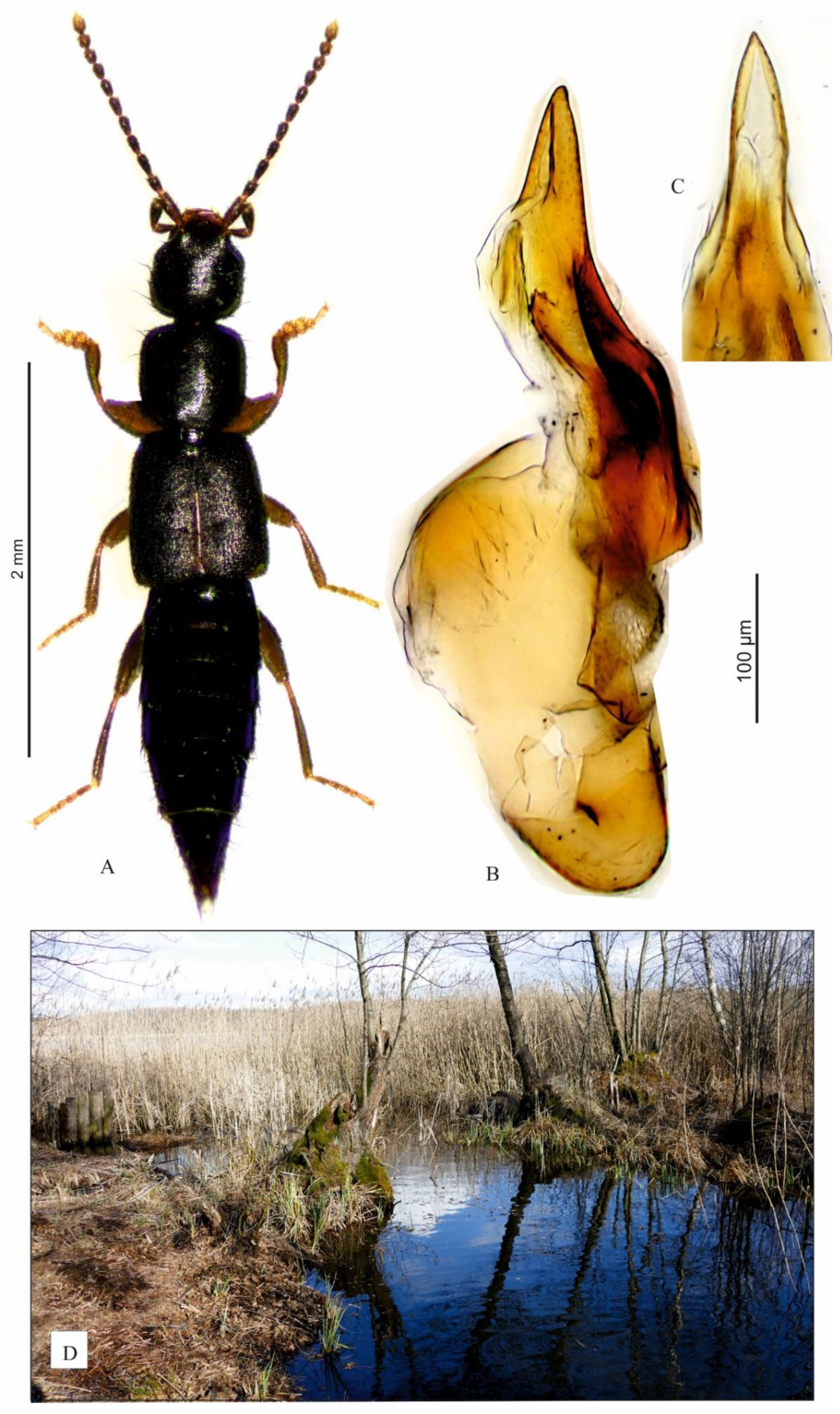
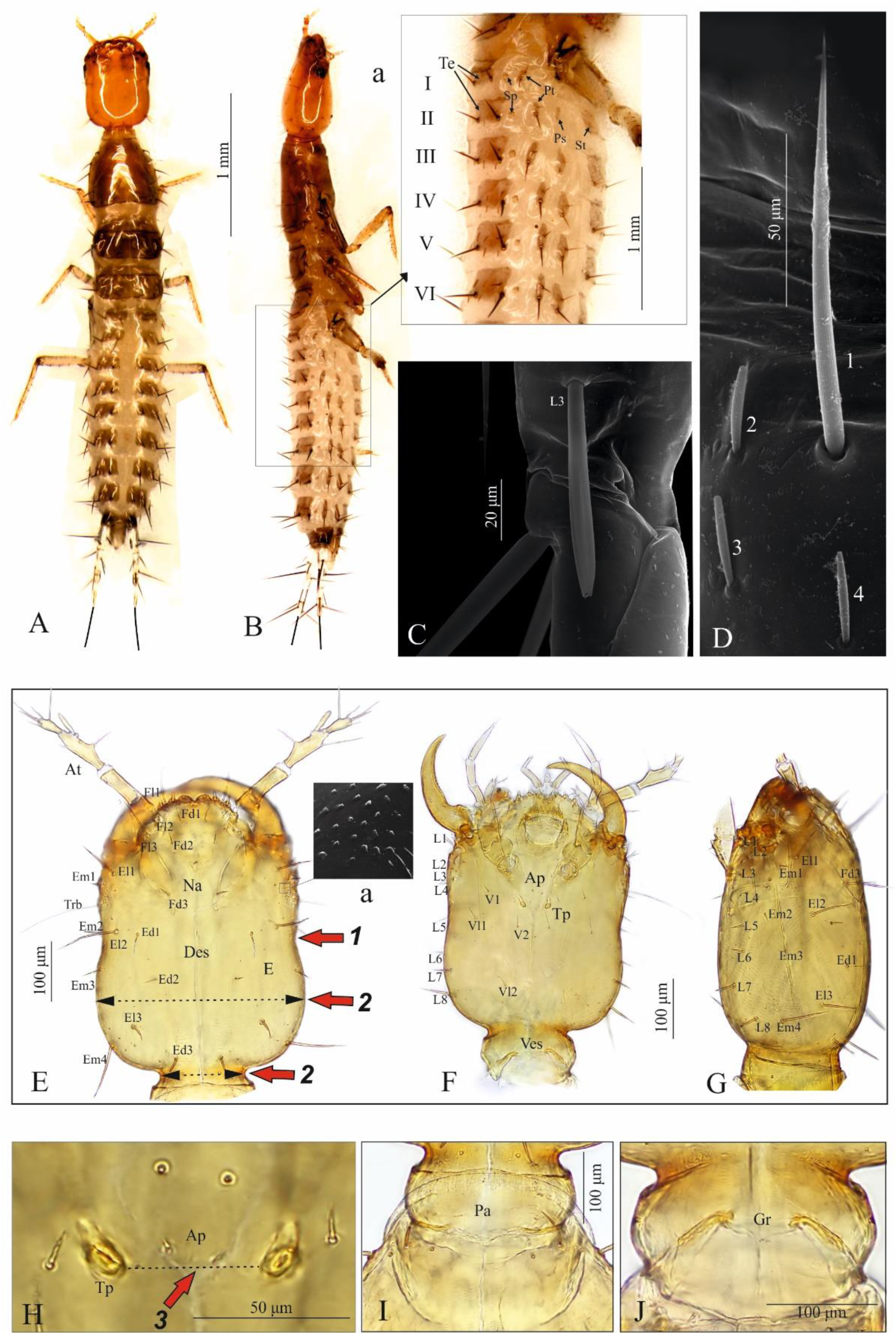
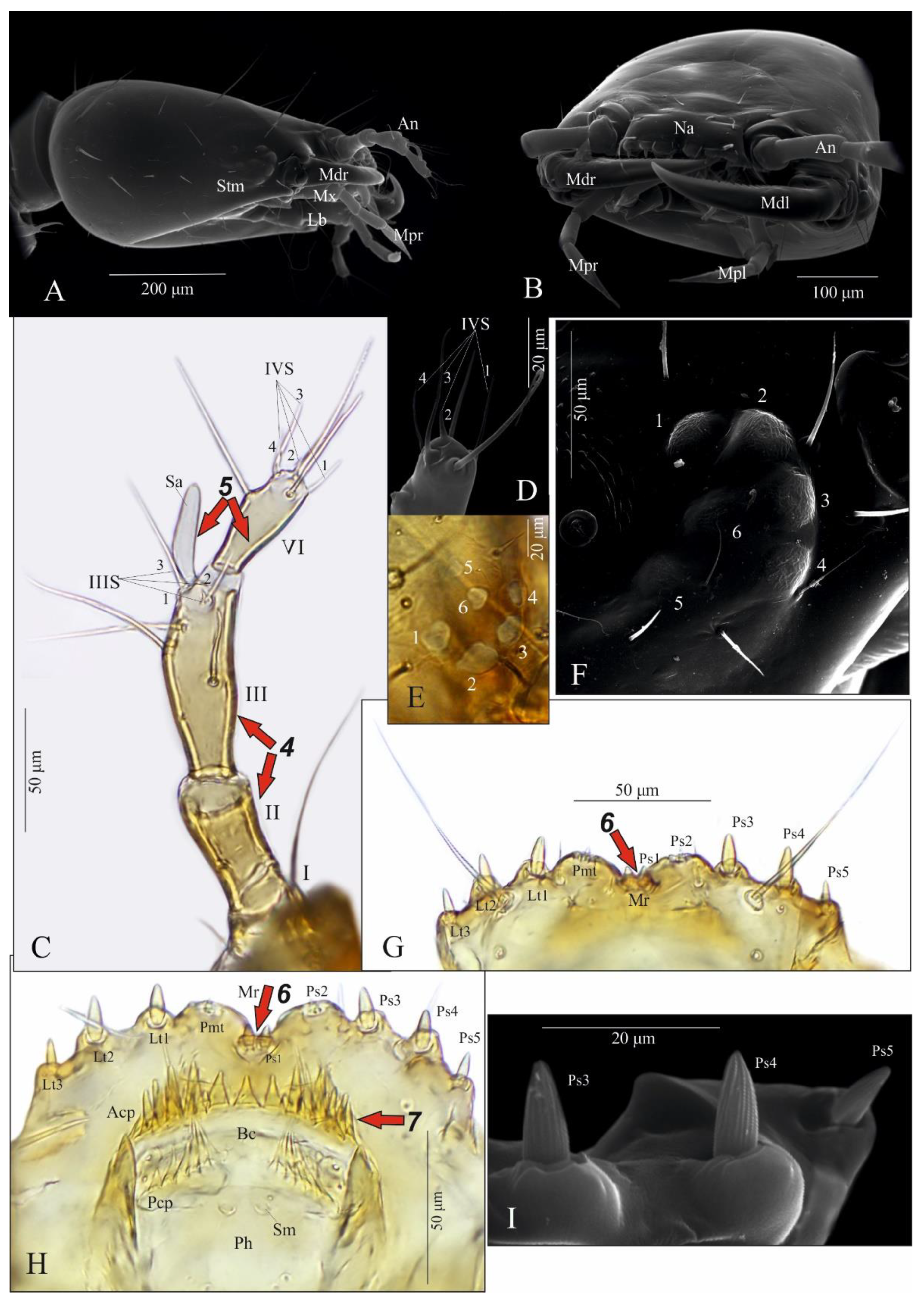
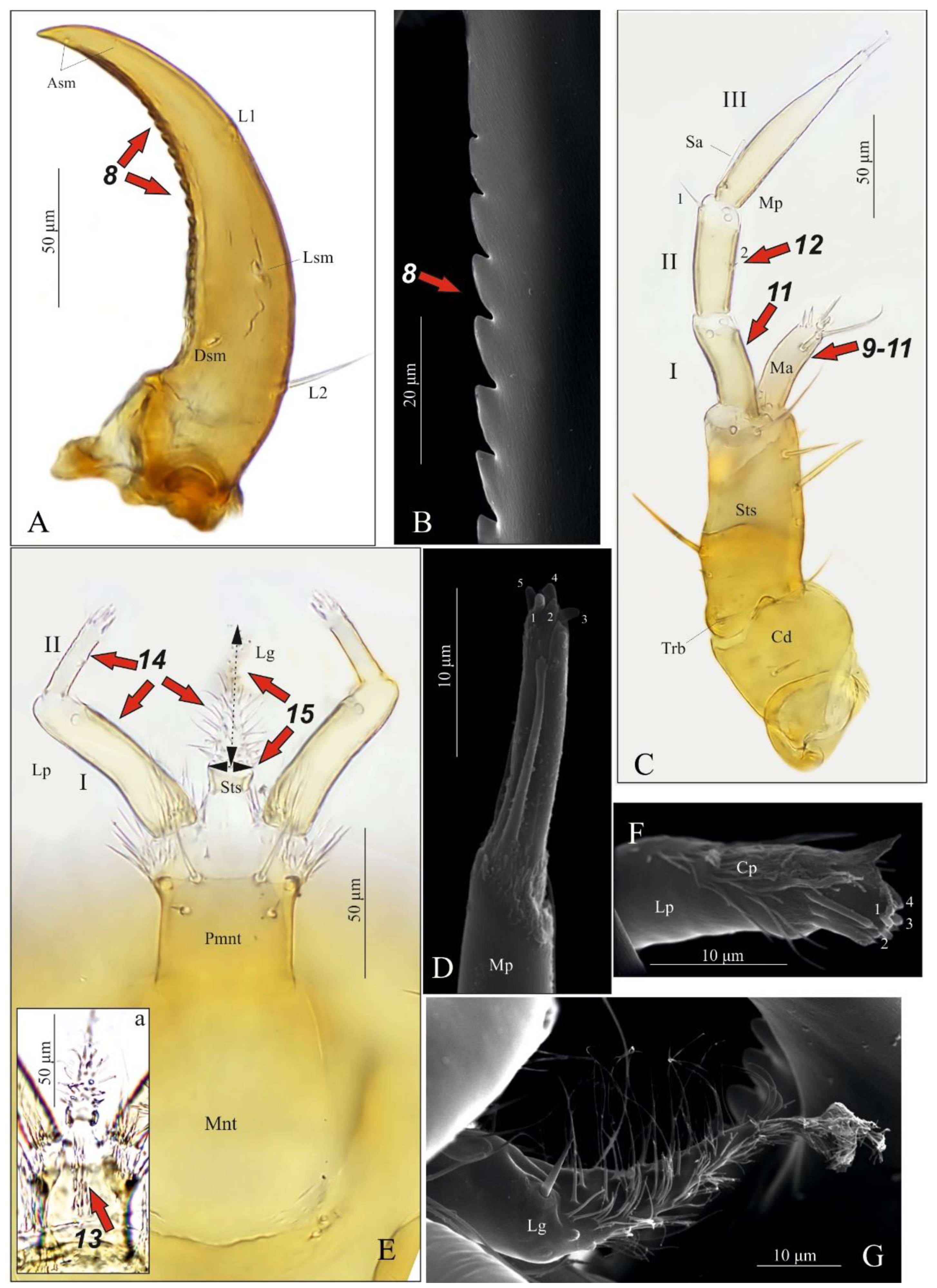
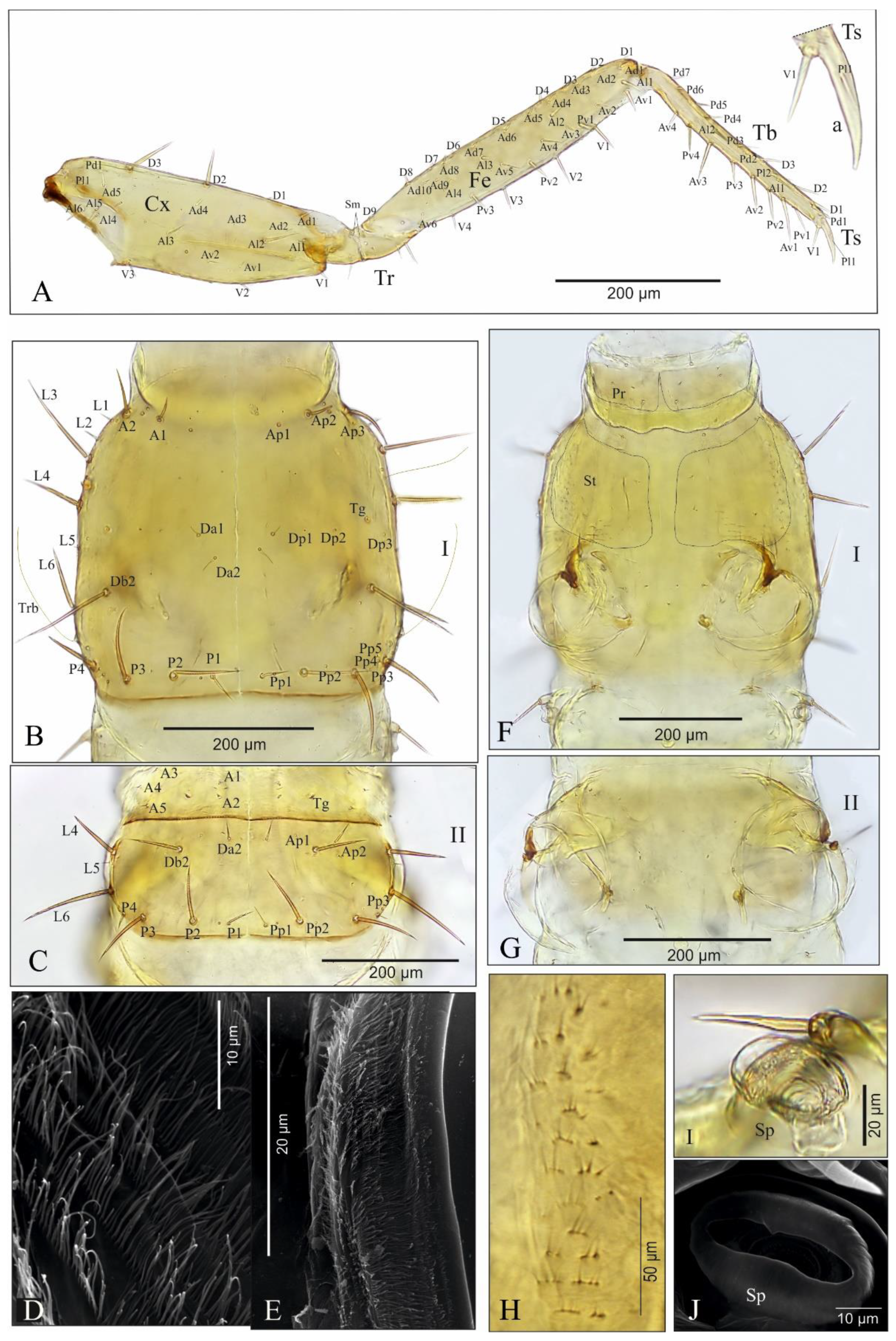
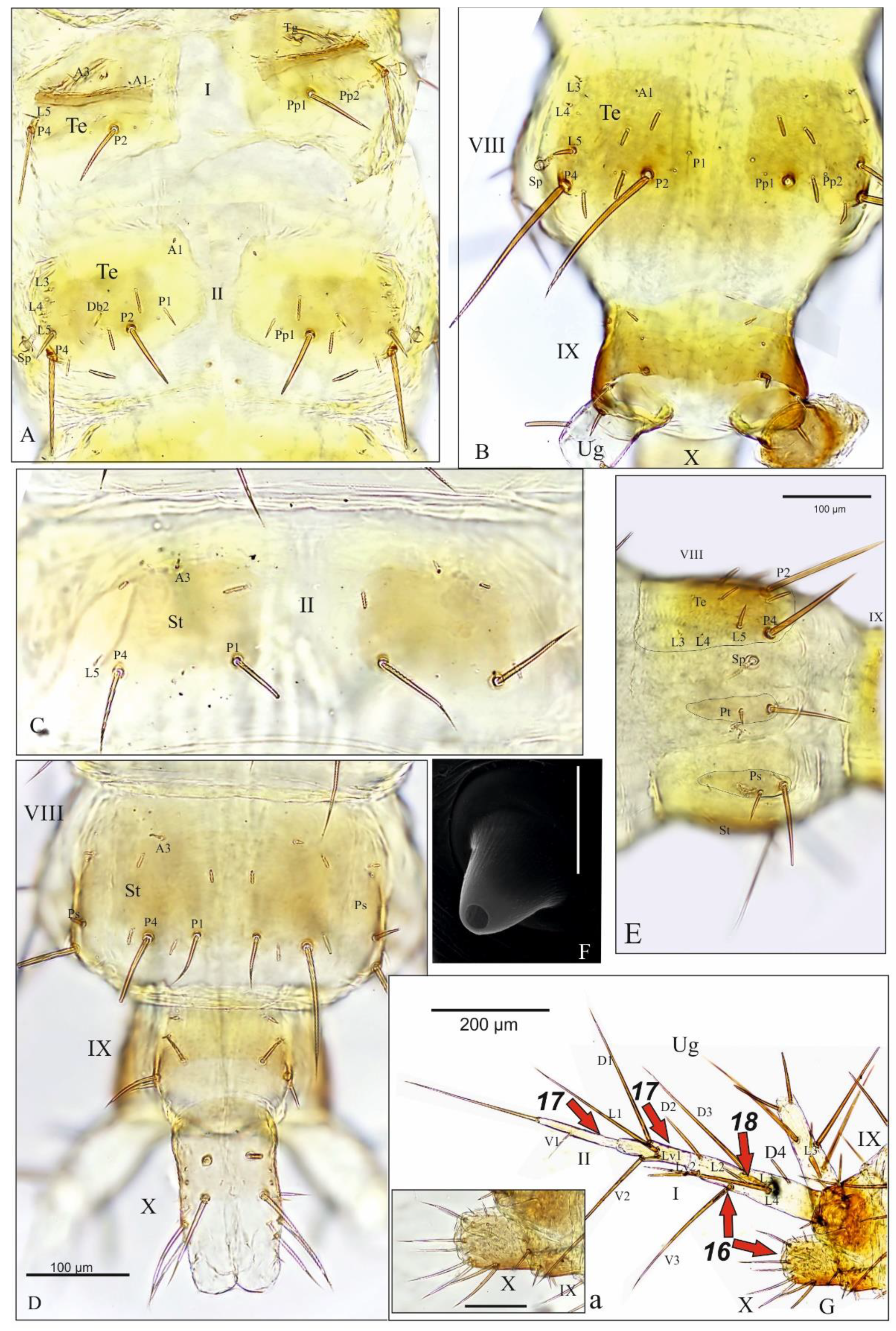
| Species | Descriptions | Illustrations | TSK | References * | ||||
|---|---|---|---|---|---|---|---|---|
| GH | ST | SK | GH | ST | SK | |||
| Tribe: Pinophilini | ||||||||
| Pinophilini Nordmann, 1837 | absent | general | - | absent | H, An, Md, Mx, Lb, L, T, Ug | poor | poor | [19], pp. 184–186 |
| Tribe: Lathrobiini sensu novo | ||||||||
| Astenus sp. Dejean, 1833 | absent | DKChO | fair | absent | absent | - | fair | [12], p. 54 |
| absent | DKChO | fair | absent | absent | - | fair | [13], p. 310 | |
| A. ?angustatus (Paykull, 1789) | absent | absent | - | absent | Na, Mx | poor | poor | [12], p. 53 |
| A. altivagans Bernhauer, 1939 | present | SS | poor | absent | H, An, Md, Mx, T, L, A4, Ug | poor | poor | [16], pp. 358–359 |
| Deroderus sp. Sharp, 1886 | absent | AS | good | absent | Ep | poor | good | [3], pp. 2547, 2550–2553 |
| Domene (Canariomene) alticola Oromi & Hernández, 1986 | present | AS | fair | present | An, Na, Md, Mx, Lb, T, L, Ug | fair | fair | [28], pp. 89–93 |
| D. (C.) benahoarensis Oromi & Martin, 1990 | present | AS | fair | present | H, An, Na, Md, Mx, Lb, T, L, A3, Ug | fair | fair | [28], pp. 80–84, 93 |
| D. (C) vulcanica Oromi & Hernández, 1986 | present | AS | fair | present | H, An, Na, Md, Mx, Lb, T, L, Ug | fair | fair | [28], pp. 85–88, 93 |
| Eustilicusfasta (Sanderson, 1947) | present | AS | very good | present | H, Lr, Md, Mx, Lb, T, L, A, Ug | good | very good | [3], pp. 2544–2550 |
| E. tristis (Melsheimer, 1844) = Stilicolina tristis (Melsheimer, 1846) | absent | SS | poor | absent | H, An, Mx, Lb, T | poor | poor | [29], pp. 6–7 |
| Lathrobium sp. Gravenhorst, 1802 | absent | DKChO | fair | absent | absent | - | fair | [12], pp. 52 |
| present | DKChO | fair | absent | absent | - | fair | [13], pp. 310 | |
| present | SS | poor | absent | H, Ug | poor | poor | [19], pp. 199–200 | |
| absent | - | - | absent | H, Na, Mx, Lb | poor | poor | [12], pp. 51 | |
| Lathrobium (Glyptomerus) alzonai Capra & Binaghi, 1938 | present | SS | fair | absent | An, Na, Mx, Lb, L, Ug | poor | fair | [30], pp. 29–33 |
| L. (G.) freyi Koch, 1938 | present | SS | fair | present | An, Na, Mx, Lb, L, Ug | poor | fair | [31], pp. 219–221 |
| Lathrobium (G.) cavicola (Müller, 1856) = Glyptomerus cavicola Müller, 1856 | present | general | poor | absent | H, An, Mx, Lb, L | poor | poor | [19], pp. 202–203 |
| absent | DKChO | fair | absent | An, Lr, Mx, Lb, Ug | poor | fair | [30], pp. 31–33 | |
| absent | DKChO | fair | absent | H, An, Mx, Lb, L, ** | poor | fair | [11], pp. 36–37, 87 | |
| L. (Lathrobium) brunnipes (Fabricius, 1792) | absent | - | - | absent | H, Na, Mx, Lb | poor | poor | [12], pp. 51 |
| absent | DKChO | fair | absent | Md, Lr, A9,10 | poor | fair | [11], pp. 35, 39 | |
| absent | absent | - | absent | Na, Mx | poor | poor | [13], pp. 321 | |
| L. (L.) elongatum (Linnaeus, 1767) | absent | absent | - | absent | An, Ug | poor | poor | [13], pp. 321, 322 |
| absent | DKChO | fair | absent | Lr, Md, A9,10 | poor | fair | [11], pp. 35, 39 | |
| present | SS | poor | absent | H, Mx, L, Ug | poor | poor | [19], pp. 200–201 | |
| L. (L.) fulvipenne (Gravenhorst, 1806) | absent | DKChO | fair | absent | Lr, Md | poor | fair | [11], pp. 35, 39 |
| L. (L.) geminum Kraatz, 1857 = L. rufescens Motschulsky, 1860 | absent | DKChO | fair | absent | An, Lr, Md, Mx, Lb, Ug | poor | fair | [11], pp. 35, 39 |
| L. (L.) grande (LeConte, 1863) | present | AS | good | absent | H, An, Na, Md, Mx, Lb, T, L, A5,9,10, Ug | fair | good | [9], pp. 146–149 |
| L. (L.) lineatocolle Scriba, 1859 | present | AS | very good | present | AS | very good | very good | [7], pp. 2–14 |
| Lobrathium badium (Cameron, 1924) = Lathrobium badium Cameron, 1924 | present | SS | poor | absent | H, Lb, T, L, A3 | poor | poor | [19], pp. 201–202 |
| L. emarginatum (Watrous, 1981) = Lathrobium emarginatum Watrous, 1981 | absent | ? | - | absent | absent | - | - | [9], p. 150 |
| Lithocharis sp. Dejean, 1833 | absent | DKChO | fair | absent | absent | - | fair | [13], p. 310 |
| present | SS | poor | absent | absent | - | poor | [19], pp. 197, 199 | |
| L. nigriceps Kraatz, 1859 | absent | absent | - | absent | H | poor | poor | [19], pp. 198–199 |
| L. vilis Kraatz, 1859 | absent | DKChO | fair | absent | H, An, Lr, Lb, A10 ** | poor | fair | [11], p. 38 |
| absent | absent | - | absent | H, An, Lr, Mx, Lb, L, T, A3 | poor | poor | [19], p. 198 | |
| Medon sp. Stephens, 1833 | absent | DKChO | fair | absent | absent | - | fair | [12], p. 54 |
| M. johni Blackwelder, 1943 | absent | AS | good | absent | Mx, T | good | good | [3], pp. 2548–2549, 2553–2554 |
| Myrmecosaurus solenopsidis Wasmann, 1909 | present | SS | poor | absent | H, Mx, Lb, L, Ug | poor | poor | [19], pp. 191, 194, |
| Rugilus sp. Leach, 1819 = Stilicus Berthold, 1827 | absent | DKChO | fair | absent | absent | - | fair | [12], p. 54 |
| DKChO | fair | absent | absent | - | fair | [13], p. 310 | ||
| absent | AS | good | absent | Lr, Ep, Lb | good | good | [3], pp. 2547–2548, 2554 | |
| R. (Rugilus) orbiculatus (Paykull, 1789) = Stilicus orbiculatus Paykull, 1789 | absent | absent | - | absent | H, Mx, Lb | poor | poor | [12], p. 53 |
| absent | DKChO | - | absent | Na, Ug | poor | poor | [13], p. 322 | |
| absent | DKChO | fair | absent | H, Mx, Ug ** | poor | fair | [11], pp. 33, 38 | |
| present | SS | poor | absent | H, An, Mx, Lb, T, L, A3, Ug | poor | poor | [19], pp. 195–197 | |
| R. (R.) rufipes Germar, 1836 | absent | DKChO | fair | absent | Lr, Ep, Md, Mx, Lb, L, Ug | poor | fair | [11], pp. 34, 38 |
| present | AS | good | present | H, Lr, An, Na, Md, Ep, Mx, Lb, T, A, Ug | good | good | [10], pp. 234–242 | |
| Stilocharis sp. Sharp, 1886 | absent | SS | good | absent | H, L, Ug | poor | good | [3], pp. 2546, 2552–2553 |
| Tetartopaeus quadratus (Paykull, 1789) | present | AS | very good | present | AS | very good | very good | [7], pp. 2–14 |
| Tribe: Paederini sensu novo | ||||||||
| Ochtephilum sp. Stephens, 1829 = Cryptobium sp. Mannerheim, 1830 | absent | DKChO | fair | absent | H, Na, An, Mx, Lb | poor | fair | [12], pp. 51–52 |
| absent | DKChO | fair | absent | absent | - | fair | [13], p. 310 | |
| O. fracticorne (Paykull, 1800) = C. fracticorne (Paykull, 1798) | absent | DKChO | fair | absent | H, An, Md, Lb, Ug ** | poor | fair | [11], pp. 37–38 |
| present | SS | poor | absent | H, An, Md, Mx, Lb, T, A4, Ug | poor | poor | [19], pp. 192–193 | |
| Paederus sp. Fabricius, 1775 | absent | DKChO | fair | absent | absent | - | fair | [12], p. 52 |
| absent | DKChO | fair | absent | absent | - | fair | [13], p. 310 | |
| P. (Eopaederus) basalis Bernhauer, 1914 | absent | SS | poor | absent | Lr | poor | poor | [19], p. 191 |
| absent | SS | poor | absent | absent | - | poor | [16], p. 355 | |
| absent | DKChO | ? | absent | - | - | ? | [15], p. 188 | |
| P. (E.) caligatus Erichson, 1840 | absent | SS | poor | absent | H, Mx | poor | poor | [19], pp. 187–188 |
| absent | DKChO | poor | absent | H ** | poor | poor | [11], pp. 33–38 | |
| absent | DKChO | ? | absent | absent | - | ? | [15], p. 188 | |
| P. (Heteropaederus) fuscipes Curtis, 1826 | absent | SS | poor | absent | An, Mx, Lb, L, Ug | poor | poor | [19], pp. 189, 190 |
| present | SS | poor | absent | absent | - | poor | [14], pp. 200–201 | |
| present | DKChO | fair | absent | A6 | poor | fair | [32], pp. 29–31 | |
| ? | ? | ? | ? | ? | ? | ? | [18], ? | |
| present | ? | ? | present | H, An | poor | ? | [17], ? | |
| absent | DKChO | poor | absent | absent | - | poor | [11], pp. 38 | |
| P. (H.) alfierii Koch, 1934 | present | AS | good | present | H, An, Na, Md, Ep, Mx, Lb, L, T, A5, Ug | fair | good | [8], pp. 129–136 |
| P. (Poedermorphus) littoralis Gravenhorsth, 1802 | absent | absent | - | absent | Na, Mx, Lb | poor | poor | [12], p. 51 |
| present | SS | fair | absent | H, Lr, An, Md, Mx, Lb, Hp, T | fair | fair | [15], pp. 184–189 | |
| present | AS | very good | present | AS | very good | very good | [7], pp. 2–10, 12–14 | |
| P. (Paederus) riparius (Linneus, 1758) | present | absent | - | absent | Na | poor | poor | [13], p. 322 |
| absent | absent | - | present | H, Hp, A | poor | poor | [27], p.p 117, 123 | |
| P. (P.) sabaeus Erichson, 1840 | present | SS | poor | absent | H, An, Md, Mx, Lp, L, A3, Ug | poor | poor | [19], pp. 190, 191 |
| absent | SS | poor | absent | absent | - | poor | [16], p. 355 | |
| absent | DKChO | ? | absent | absent | - | ? | [15], p. 188 | |
| P. columbinus Laporte, 1835 | present | SS | poor | present | H, Lr, An, Md, Mx, T, A7-9 | fair | poor | [33], pp. 43–47 |
| P. conspicuous Erichson, 1840 | absent | DKChO | poor | absent | absent | - | poor | [33], p. 42 |
| P. hintzi Bernhauer, 1915 = P. steelei Bernhauer, 1939 | present | SS | poor | absent | H, Mx, L, A4, Ug | poor | poor | [16], pp. 354–355 |
| P. machadoi Sheerpeltz, 1965 | absent | DKChO | poor | absent | absent | - | poor | [33], p. 42 |
| P. marcuzzii Sheerpeltz, 1965 | absent | DKChO | poor | absent | absent | - | poor | [33], p. 42 |
| P. signaticornis Sharp, 1886 | absent | DKChO | poor | absent | absent | - | poor | [33], p. 42 |
| P. tempestivus Erichson, 1840 | absent | DKChO | poor | absent | absent | - | poor | [32], p. 31 |
| absent | DKChO | - | absent | - | - | [15], p. 188 | ||
| Paederidus algiricus antoinei (Koch, 1937) = Paederus antoinei Koch, 1937 | absent | SS | poor | absent | An, Mx, Lb, L, Ug | poor | poor | [19], pp. 188–189 |
| absent | DKChO | ? | absent | absent | - | ? | [15], p. 188 | |
| Paederidus rubrothoracicus Goeze, 1777 | absent | SS | poor | absent | absent | - | poor | [19], p. 188 |
| absent | DKChO | ? | absent | absent | - | ? | [15], p. 188 | |
| P. rubrothoracicus carpathicola (Scheerpeltz, 1957) | present | AS | very good | present | AS | very good | very good | [6], pp. 41, 44–50, 52–55 |
| P. ruficollis (Fabricius, 1777) | present | AS | fair | absent | H, Lr, A6 | poor | fair | [32], pp. 27–31 |
| present | AS | very good | present | AS | very good | very good | [6], pp. 41–50, 53–55 | |
| absent | DKChO | ? | absent | absent | - | ? | [15], pp. 186, 188 | |
| Measurements (mm) | Instar/N | |||||
|---|---|---|---|---|---|---|
| L1/8 | L2/7 | |||||
| RM | M | SD | RM | M | SD | |
| Body length | 1.32–3.10 | 2.50 | 0.69 | 3.30–3.99 | 3.56 | 0.40 |
| Thorax length | 0.54–1.00 | 0.88 | 0.18 | 1.10–1.50 | 1.32 | 0.19 |
| Pronotum width | 0.26–0.36 | 0.33 | 0.07 | 0.36–0.44 | 0.39 | 0.02 |
| Head width | 0.30–0.36 | 0.33 | 0.03 | 0.41–0.43 | 0.42 | 0.01 |
| Head length | 0.30–0.53 | 0.43 | 0.09 | 0.53–0.57 | 0.55 | 0.02 |
| Character | i. Oral Opening | ii. Seta on At ArII | iii. Length of At Sa | iv. Number of Teeth on Na; v. Gap between Pmt | vi. row of Acp of Epipharynx; Tuft of Acp Medially | vii. Rw; viii. sensilla on ArII of Mp and Lp | ix. Shape of Sts | x. Shape of Lg | xi. Shape of Ma |
|---|---|---|---|---|---|---|---|---|---|
| Paederini sensu novo | wide | present | short | 4; present | incomplete; present | present; absent | trapeziform | conical | slim * |
 |  |  | 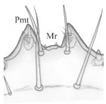 |  |  | 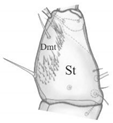 |  |  | |
| Lathrobiini sensu novo | narrow | absent | long | 7–9; absent | complete; absent | absent; present | rectangular | bulbif-form | robust ** |
 |  | 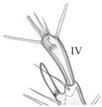 |  | 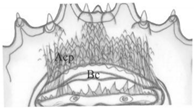 |  |  |  |  |
| Character | Tribe/Subtribe/Genus/Species | |||||
|---|---|---|---|---|---|---|
| LATHROBIINI | PAEDERINII | |||||
| Medonina | Lathrobiina | Stilicina | Paederina | |||
| Pseudomedon | Lathrobium | Tetartopeus | Rugilus sp., | Paederus | Paederidus | |
| obsoletus | lineatocolle | quadratus | R. rufipes | littoralis | ruficollis | |
| Body length | 3.3–4.0 | 4.1–5.2 | 4.5–4.9 | 5.5–7.5 | 5.0-5.1 | 5.2–7.3 |
| Mss | present | present | present | ? | absent | absent |
| HEAD | ||||||
| Width | 0.30–0.36 | 0.8–0.9 | 0.71–0.75 | ? | 0.82–0.8 | 0.74–0.83 |
| Length | 0.30–0.53 | 0.9–1.2 | 0.9–1.0 | ? | 0.73–0.94 | ? |
| Shape in outline | rectangular | U-shaped | semi-U-shaped | rectangular | trapezoidal | semicircular |
| Wr: head to neck | 2.5:1 | 3.6:1 | 1.8:1 | 3.1:1 | 1.9:1 | 1.9:1 |
| NmaS: epicranial part | 10 | 14 | 16 | 20 | 24 | 22 |
| NmiS: dorsal and ventral side | absent | numerous | numerous | numerous | absent | absent |
| Ap | present | present | present | absent | present | absent |
| Ap: position with respect to Tp | extending to Tp | reaching Tp | reaching Tp | - | extending to Tp | - |
| ANTENNA | ||||||
| Asg Ar II: seta | absent | absent | absent | absent | present | present |
| Ar III: shape of Sa | slightly curved | slightly curved | slightly curved | slightly curved | erect | erect |
| Lr: Sa and Ar IV | 1:1.2 | 1:1.5 | 1:1 | 1:1.5 | 1:2.9 | 1:2.1 |
| Ar II-IV: Lwr | 7.4×, 7.3×, 5.2× | 4.1×, 3.6×, 3.3× | 3.1×, 3.5×, 2.6× | 3.7×, 4×, 4.3× | 3.3×, 3.9×, 3.8× | 2.9×, 3.6×, 3.3× |
| Lwr: Ar I-IV | 1:2.7:4.1:2.4 | 1:4.7:4.1:2.3 | 1:2.0:2.3:1.1 | 1:4.4:4.4:2.7 | 1:4.1:4.4:3.0 | 1:2.7:3.3:2.0 |
| NASALE | ||||||
| Nt.Am | 8 | 7 | 7 | 8 | 4 | 4 |
| Mt: anterior margin | absent | present | present | absent | absent | absent |
| Gap between Pmt | absent | absent | absent | absent | present | present |
| Npgs | 10 | 10 | 10 | 8 | 10 | 8 |
| EPIPHARYNX | ||||||
| Row of Acp | complete | complete | complete | complete | incomplete | incomplete |
| Acp: Ncp | 22–25 | about 25 | about 50 | ? | about 120 | about 100 |
| Microstructure | absent | present | present | present | absent | absent |
| MANDIBLE | ||||||
| Inner margin | serrate | smooth | serrate | serrate | serrate | serrate |
| Bm | absent | absent | absent | ? | present | present |
| MAXILLA | ||||||
| Stipes: shape | rectangular | rectangular | rectangular | rectangular | tapering to the top | tapering to the top |
| Stipes: Lwr | 1.9× | 2.2× | 2.0× | 1,8× | 1.4× | 1.4× |
| Mala: Lwr | 3.1× | 3.5× | 2.6× | 3.8× | 2.8× | 3× |
| MAXILLARY PALP | ||||||
| Lr: mala and Ar I | 1:1 | 1:1.3 | 1:1.6 | 1.1:1 | 1:2.0 | 1:2.2 |
| Wr: mala and Ar I | 1:1.2 | 1:1 | 1:1.5 | 1:1.4 | 1:3 | 1:3.2 |
| Ar I-III: Lwr | 5.8×, 7×, 13.4× | 4.2×, 4.1×, 8.6× | 4.1×, 4.2×, 11× | 2.8×, 5.1×, 9.6× | 1.9×, 2.8×, 5.8× | 1.6×, 2×, 4.1× |
| Lr of Ar I-III | 1:1.1:2.4 | 1:1:1.6 | 1:1:2 | 1:1.5:2 | 1:1.5:2.4 | 1:1.6:2.4 |
| Ar II: seta 2: length/position | short/ at half-length | short/ at half-length | short/ at half-length | short/ close to top | long/basally | long/basally |
| Tsm | long | long | long | long | rudimentary | rudimentary |
| Ar III: Rw | absent | absent | absent | absent | present | present |
| HYPOPHARYNX | ||||||
| Microtrichia: number/position | over a dozen/central | numerous/ anterocentral | numerous/ anterocentral and lateral | ? | numerous/ anterocentral | numerous/ anterocentral |
| LABIUM | ||||||
| Lg: Lwr | 3.1× | 2.4× | 2.3× | ? | 2.1× | 1.8× |
| Lg: shape | bulbiform | bulbiform | bulbiform | bulbiform | conical | conical |
| Sts | present | present | present | present | absent | absent |
| Pmnt: shape | extended anteriorly | extended anteriorly | rectangular | extended anteriorly | trapeziform | trapeziform |
| LABIAL PALP | ||||||
| Lg and Ar I: Lr | 1:1.3 | 1:1.4 | 1:1.6 | 1:1.3 | 1:1 | 1:1 |
| Ar I-II: Lwr | 3.4×, 2.6× | 3.9×, 4× | 2.9×, 3× | 5×, 6.8× | 4×, 7× | 3×, 5× |
| Ar I-II: Lr | 2.1:1, | 1.7:1 | 1.9:1 | 1.6:1 | 1.5:1 | 1.3:1 |
| Ar II: Rw | absent | absent | absent | absent | present | present |
| Ar II: shape | curved | curved | curved | erect | erect | erect |
| Tsm | long | long | long | long | rudimentary | rudimentary |
| UROGOMPHUS | ||||||
| Ar I: Ns | 12 | 14 | 14 | 11 | ? | 10 |
| Ar I, Ar II, Sap: Lr | 2.5:1:1.6 | 3.9:1:2.5 | 4.9:1:1.7 | 1.5:1:1.5 | ? | 2.4:1:1.4 |
| Lwr Ar I | 6.5× | 8.5× | 11.8× | 5.5× | ? | 7× |
| Ug and Pg: Lr | 4.4:1 | 3.3:1 | 6.5:1 | ? | ? | 6.7–7.1:1 |
| References | present study | [7] | [3,10] | [6] | ||
Publisher’s Note: MDPI stays neutral with regard to jurisdictional claims in published maps and institutional affiliations. |
© 2022 by the authors. Licensee MDPI, Basel, Switzerland. This article is an open access article distributed under the terms and conditions of the Creative Commons Attribution (CC BY) license (https://creativecommons.org/licenses/by/4.0/).
Share and Cite
Staniec, B.; Pietrykowska-Tudruj, E.; Wagner, G.K.; Mazur, A.; Kowalczyk, M. Synthesis of Current Knowledge of the Morphology of the Larval Stages of Paederinae (Coleoptera; Staphylinidae), with a First Insight into the Mature Larva of Pseudomedon Mulsant & Rey, 1878, in the Light of a New Systematic Division. Insects 2022, 13, 982. https://doi.org/10.3390/insects13110982
Staniec B, Pietrykowska-Tudruj E, Wagner GK, Mazur A, Kowalczyk M. Synthesis of Current Knowledge of the Morphology of the Larval Stages of Paederinae (Coleoptera; Staphylinidae), with a First Insight into the Mature Larva of Pseudomedon Mulsant & Rey, 1878, in the Light of a New Systematic Division. Insects. 2022; 13(11):982. https://doi.org/10.3390/insects13110982
Chicago/Turabian StyleStaniec, Bernard, Ewa Pietrykowska-Tudruj, Grzegorz K. Wagner, Andrzej Mazur, and Magdalena Kowalczyk. 2022. "Synthesis of Current Knowledge of the Morphology of the Larval Stages of Paederinae (Coleoptera; Staphylinidae), with a First Insight into the Mature Larva of Pseudomedon Mulsant & Rey, 1878, in the Light of a New Systematic Division" Insects 13, no. 11: 982. https://doi.org/10.3390/insects13110982
APA StyleStaniec, B., Pietrykowska-Tudruj, E., Wagner, G. K., Mazur, A., & Kowalczyk, M. (2022). Synthesis of Current Knowledge of the Morphology of the Larval Stages of Paederinae (Coleoptera; Staphylinidae), with a First Insight into the Mature Larva of Pseudomedon Mulsant & Rey, 1878, in the Light of a New Systematic Division. Insects, 13(11), 982. https://doi.org/10.3390/insects13110982






